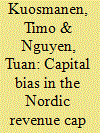| Srl | Item |
| 1 |
ID:
176667


|
|
|
|
|
| Summary/Abstract |
Nordic energy market reform and the regulation of local monopolies in electricity transmission and distribution sectors have served as role models for many other countries worldwide. The first contribution of this paper is to clarify the conceptual distinction between the Nordic revenue cap approach and the British revenue cap regulation. Our second contribution is to show that the Nordic revenue cap is similar to the U.S.-style rate of return regulation in that both are subject to capital bias, known as the Averch-Johnson effect. The third contribution of this paper is to examine the magnitude of the capital bias and its welfare effects by means of numerical simulations. We show that the Nordic revenue cap generally decreases the monopoly profit, increases the output, decreases the price, and hence increases consumer surplus compared to the unregulated monopoly. The simulation results prove robust to changes in the parameter values and the functional form of the production function. Our numerical simulations reveal that relatively light handed regulation suffices to yield the main benefits.
|
|
|
|
|
|
|
|
|
|
|
|
|
|
|
|
| 2 |
ID:
125569


|
|
|
|
|
| Publication |
2013.
|
| Summary/Abstract |
Electricity distribution is a natural local monopoly. In many countries, the regulators of this sector apply frontier methods such as data envelopment analysis (DEA) or stochastic frontier analysis (SFA) to estimate the efficient cost of operation. In Finland, a new StoNED method was adopted in 2012. This paper compares DEA, SFA and StoNED in the context of regulating electricity distribution. Using data from Finland, we compare the impacts of methodological choices on cost efficiency estimates and acceptable cost. While the efficiency estimates are highly correlated, the cost targets reveal major differences. In addition, we examine performance of the methods by Monte Carlo simulations. We calibrate the data generation process (DGP) to closely match the empirical data and the model specification of the regulator. We find that the StoNED estimator yields a root mean squared error (RMSE) of 4% with the sample size 100. Precision improves as the sample size increases. The DEA estimator yields an RMSE of approximately 10%, but performance deteriorates as the sample size increases. The SFA estimator has an RMSE of 144%. The poor performance of SFA is due to the wrong functional form and multicollinearity.
|
|
|
|
|
|
|
|
|
|
|
|
|
|
|
|